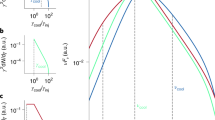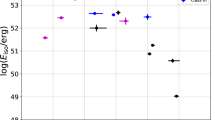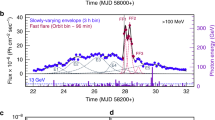Abstract
The thermal synchrotron (TS) interpretation of γ-ray burst continuum spectra1 has recently gained support from the analysis of an expanding database2–5. However, this interpretation requires an emission region which is hot (kT∼0.2–1mc2), optically very thin (nh ≲ 1021 cm−2) with a highly super-Eddington flux F ∼ 1030 erg cm−2 s−1 (»FEdd = 1025 M/M⊙) for a 10-km neutron star. This picture is similar to that first proposed for the 5 March 1979 event6–8. In addition there are hints that the emission layer is very dense (ne ⩽ 1024-1026 cm−3) and thin (h ⩽ 10−3 cm). For example, events which show simultaneous redshifted 511-keV annihilation lines and low energy self-absorption (see Fig. 1) allow us to estimate a lower limit in the range 1023-1026 cm−1 (ref. 9) to the pair density, provided that the annihilation region coincides with the synchrotron source. To maintain the pair population close to maxwellian, the collision excitation rate into higher Landau levels9 (that is, the pitch-angle scattering rate) must exceed the cyclotron decay rates. Coulomb scattering between pairs and protons is too slow. Even if collective processes whose rates are close to the electron plasma frequency, or scattering by heavy ions (for example, Z = 26, rates ∝ Z2), are invoked, a particle density n ⩾ 1025 cm−3 is still needed. Both arguments point towards a dense but thin emitting sheet with h ≲ 10−3–10−5 cm. The severe energetics and persistence of such a hot, dense, thin emitting layer prompted us to consider a picture in which the emission regions lie at the foot points of reconnecting magnetic loops, powered by downward impinging electromagnetic waves. We now examine the structure of the emitting sheet, and the generation, propagation and coupling of the electromagnetic energy fluxes to the surface layer, and show that a flare-like model can account for most of the general features of γ-ray bursts.
This is a preview of subscription content, access via your institution
Access options
Subscribe to this journal
Receive 51 print issues and online access
$199.00 per year
only $3.90 per issue
Buy this article
- Purchase on Springer Link
- Instant access to full article PDF
Prices may be subject to local taxes which are calculated during checkout
Similar content being viewed by others
References
Liang, E. P., Jernigan, T. E. & Rodrigues, R. Astrophys. J. 271, 766–777 (1983).
Mazets, E. P. et al. Astrophys. Space Sci. 80, 3–83 (1981).
Barat, C. Proc. Santa Cruz Workshop on High Energy Transients (ed. Woosley, S.) (AIP, New York, 1984).
Desai, U. D. et al. Proc. COSPAR Cosmic-Ray Symp., Bangalore (Publisher? 1983).
Nolan, P. L. Proc. Santa Cruz Workshop on High Energy Transients (ed. Woosley, S.) (AIP, New York, 1984).
Ramaty, R., Lingenfelter, R. & Bussard, R. W. Astrophys. Space Sci. 75, 193–203 (1981).
Ramaty, R. et al. Nature 287, 122–124 (1980).
Katz, J. I. Astrophys. J. 260, 370–385 (1982).
Liang, E. P. AIP Conf. Proc. No. 101 (eds Burns, M., Harding, A. & Ramaty, R.) 81–88 (AIP, New York, 1983).
Duijveman, A., Hoyng, P. & Machado, M. E. Sol. Phys. 81, 137–157 (1982).
Ruderman, M. Ann. N.Y. Acad. Sci. 262, 164 (1975).
Katz, J. I. in AIP Conf. Proc. No. 101 (eds Burns, M. L., Harding, A. K. & Ramaty, R.) 65–75 (AIP, New York, 1983).
Parker, E. N. Astrophys. J. 264, 635–641 (1983).
Furth, H. P., Killeen, J. & Rosenbluth, M. N. Phys. Fluids 6, 459–484 (1963).
Priest, E. R. AGU Chapman Conf. on Reconnection, Los Alamos (American Geophysical Union, Washington DC, 1983).
Petschek, H. E. AAS–NASA Symp. on the Physics of Solar Flares, 425–430 (NASA Spec. Publ. SP-50, 1964).
Barnes, A. & Suffolk, G. C. J. J. Plasma Phys. 5, 315–329 (1971).
Max, C. in Les Houghes Summer School, Proc. Laser-Plasma Interactions, (eds Balian, R. & Adam, J. C.) (North-Holland, Amsterdam, 1981).
Barat, C. et al. Astr. Astrophys. 126, 400–402 (1983).
Woosley, S. in AIP Conf. Proc. No. 77 (ed. Lingenfelter, R.) 273–292 (AIP, New York, 1982).
Author information
Authors and Affiliations
Rights and permissions
About this article
Cite this article
Liang, E., Antiochos, S. Magnetic flare model of γ-ray bursts. Nature 310, 121–122 (1984). https://doi.org/10.1038/310121a0
Received:
Accepted:
Issue Date:
DOI: https://doi.org/10.1038/310121a0
This article is cited by
-
The spectra of gamma-ray bursts and emission features
Astrophysics and Space Science (1990)
-
A flare-induced cascade model of γ-ray bursts
Nature (1986)
-
Plasma radiation during γ-ray bursts
Nature (1985)
Comments
By submitting a comment you agree to abide by our Terms and Community Guidelines. If you find something abusive or that does not comply with our terms or guidelines please flag it as inappropriate.



